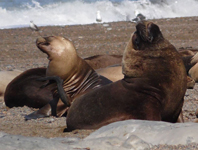Abstract
During almost two centuries, two available specific epithets have competed for the southern sea lions of the genus Otaria Péron, 1816 (Fig. 1), which is classically regarded as monotypic (but see below). The species distributes more or less continuously along the Atlantic coast from southern Brazil south to Cape Horn and along the Pacific from northern Peru to the west South American Pacific coast . While some researchers have argued that the correct name for this species is Phoca flavescens Shaw, 1800 (e.g., Cabrera, 1940, Rice, 1977; Rodriguez & Bastida, 1993; Teta et al., 2018), others have used P. byronia de Blainville, 1820 (e.g., Allen, 1905; Hamilton, 1934; King, 1978, Oliva, 1988; Berta & Churchill, 2012). This controversy originates from the fact that the diagnosis of the type of flavescens, the oldest epithet and as such the one that has priority, would not match the phenotypic features of the genus Otaria. This view, which favors the usage of byronia for populations of southern sea lions, was strongly defended by Oliva (1988:768), who argued that “…(1) the total length of the holotype [of flavescens]; (2) the size of the external ear; and (3) the color and length of the specimen’s fur do not correspond to any developmental stage of the species.” However, Rodríguez and Bastida (1993:378) discussed these same features reaching a very different conclusion, by indicating that “Shaw’s holotype, collected in the Strait of Magellan, could only have been a newborn pup of Otaria or Arctocephalus australis; its body size (circa 62 cm) could correspond to either species, but the uniform yellowish color is found exclusively in some molted pups of the Southern sea lion. Ear length, though not matching well with the described body length, lies within the recorded range of Otaria, but outside that for Arctocephalus australis.”
References
Aguayo, A. & Maturana, R. (1973) Presencia del lobo marino común Otaria flavescens en el litoral chileno. Biología Pesquera, 6, 49–75.
Allen, J.A. (1905) The Mammalia of southern Patagonia. In: Scott, W. B. (Ed.), Reports of the Princeton University Expeditions to Patagonia, 1896–1899. J. Pierpont Morgan Publication Fund, Zoology, 3 (1), pp. 1 – 210.
Artico, L.O., Bianchini, A., Grubel, K.S., Monteiro, D.S., Estima, S.C., de Oliveira, L.R., Bonatto, S.L. & Marins, L.F. (2010) Mitochondrial control region haplotypes of the South American sea lion Otaria flavescens (Shaw, 1800). Brazilian Journal of Medical and Biological Research, 43, 816–820
https://doi.org/10.1590/S0100-879X2010007500074
Bastida, R., Rodríguez, D., Secchi, E. & da Silva, V. (2007) Mamíferos acuáticos de Sudamérica y Antártida. Vázquez Mazzini Editores, Buenos Aires, 368 pp.
Berta, A. & Churchill, M. (2012) Pinniped taxonomy: review of currently recognized species and subspecies, and evidence used for their description. Mammal Review, 42, 207–234.
https://doi.org/10.1111/j.1365-2907.2011.00193.x
Brunner, S. (2003) Fur seals and sea lions (Otariidae): identification of species and taxonomic review. Systematic Biodiversity, 1, 339–-439.
https://doi.org/10.1017/S147720000300121X
Cabrera, A. (1940) Nota sobre carnívoros sudamericanos. Notas del Museo de La Plata, Zoología, 5, 1–22.
Committee on Taxonomy (2017) List of marine mammal species and subspecies. Society for Marine Mammalogy. Available from: http://www.marinemammalscience.org/ (accessed 12 July 2018)
De Blainville, H.D. (1820) Sur quelques cránes de phoques. Journal de Physique, de Chemie, d´Histoire Naturelle et des Arts, 91, 286–300.
Feijoo, M., Lessa, E.P., Loizaga de Castro, R. & Crespo, E.A. (2011) Mitochondrial and microsatellite assessment of population structure of South American sea lion (Otaria flavescens) in the Southwestern Atlantic Ocean. Marine Biology, 158 (8), 1857–1867.
https://doi.org/10.1007/s00227-011-1697-4
Hamilton, J.E. (1934) The southern sea lion, Otaria byronia (de Blainville). Discovery Reports, 8, 269–318.
ICZN (1999) International Code of Zoological Nomenclature, Fourth Edition: adopted by the International Union of Biological Sciences. London, The International Trust for Zoological Nomenclature.
King, J.E. (1978) On the specific name of the southern sea lion (Pinnipedia, Otariidae). Journal of Mammalogy, 59, 861–863.
https://doi.org/10.2307/1380156
King, J.C.H. (1996) New evidence for the contents of the Leverian Museum. Journal of the History of Collections, 8, 167–186.
https://doi.org/10.1093/jhc/8.2.167
Molina, J.E. (1782) Saggio Sulla Storia Naturale del Chili. In: Bologna: Nella Stamperia di S. Tommaso d’Aquino 1782.
https://doi.org/10.5962/bhl.title.62689
Oliva, D. (1988) Otaria byronia (de Blainville, 1820), the valid specific name for the Southern sea lion (Carnivora: Otariidae). Journal of Natural History, 22, 767–772.
https://doi.org/10.1080/00222938800770501
Pennant, T. (1793) Seals. In: Pennant, T. (Ed.), History of Quadrupeds. London: Printed for B, pp. 266–291.
Peron, I. (1816) Voyage de découvertes aux Terres Australis. Historique, Tome 2. Boston Public Library, 32–66 pp.
Pine, R.H., Angle, J.P. & Breidge, D. (1978) Mammals from the sea, mainland and islands at the southern tip of South America. Mammalia, 42, 105–114.
https://doi.org/10.1515/mamm.1978.42.1.105
Rice, D.W. (1977) A list of the marine mammals of the world, 3rd edn. NOAA Technical Reports, NMFS-SSRF, 711, 1–15.
Rodríguez, D.H. & Bastida, R. (1993) The southern sea lion, Otaria byronia or Otaria flavescens. Marine Mammal Science, 9 (4), 372–381.
https://doi.org/10.1111/j.1748-7692.1993.tb00470.x
Scheffer, V.B. (1958) Seals, sea lions and walruses: a review of the Pinnipedia. Stanford University Press. California, 179 pp.
Shaw, G. (1800) Seals. In: Kerasly, G. (Ed.). General Zoology or Systematic Natural History, Vol. I (2), pp. 266–291.
Sielfeld, W. (1983) Mamíferos marinos de Chile. Universidad de Chile, Santiago, 199 pp.
Teta, P., Abba, A.M., Cassini, G.H., Flores, D.A., Galliari, C.A., Lucero, S.O. & Ramírez, M. (2018) Lista revisada de los mamíferos de Argentina. Mastozoología Neotropical, 25, 163–198.

